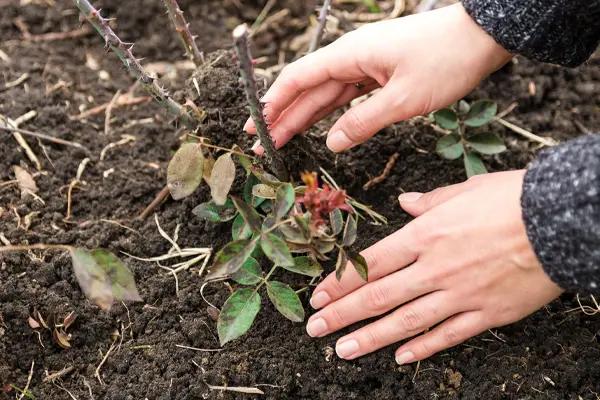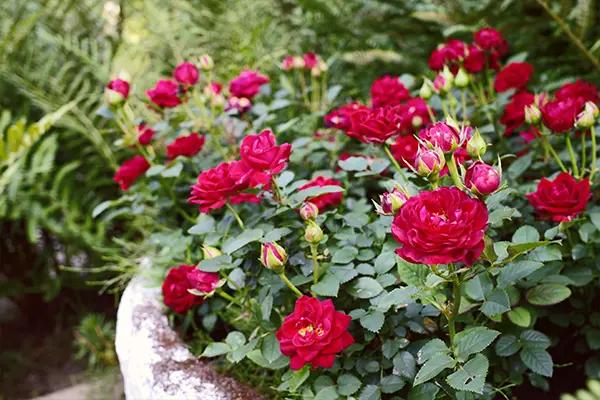All You Need to Know About Planting Roses
Rose bushes are many gardeners' favourite plant and, when well planted, can create amazing centrepieces and displays. In this complete guide to planting rose bushes, find out the best conditions for roses to thrive in, how to move them and avoid replant rose bushes, and how best to plant and care for roses in pots.

Although roses are long-suffering plants and will grow in most places, if you want them to grow as well as possible then think of three things. It doesn't matter what type of rose you're planting, you need to think of Earth, Wind and Fire.
Earth
- Roses like a moisture retentive soil, but drainage should be good. No rose likes growing in a bog. Kill 2 or 3 birds with one stone here. Masses of well rotted organic matter is the answer. It improves soil quality and enriches at the same time. When preparing a rose bed, it is well worthwhile covering it in a layer 3-4" deep of well rotted compost or horse manure and digging it over thoroughly to the depth of a spade. Your roses will be there and flowering hard for the next 20-30 years and this initial preparation will pay huge dividends all through their lives.
Wind
- Roses principally suffer from fungal diseases. Good soil helps keep them healthy, but a site where the air moves easily will also reduce the incidence of diseases such as mildew, black spot and rust. Having said which, growing roses in really exposed sites does mean that a bit of shelter for the bigger bush roses in particular is necessary.
Fire
- Roses need light. With very few exceptions indeed, roses want to be planted and grow where there is plenty of light. They love sunshine and at least want high light levels. You can grow climbing roses through a shady area though, so they can get to the sun (e.g. up & over a shady wall or through a tree). Ideally your roses should get at least half a day of sun in the summer to perform at their best.
How to Plant a Bareroot Rose
You can order bareroot roses at any time and plant them from November to April.

Choose a spot in the border with good light. Dig a hole large enough so your rose will be planted with the graft union at soil level and with plenty of room for its roots around the sides. Improve the soil from the hole by removing weeds, large stones, rubbish and roots and adding a shovel full of compost or well rotted manure. Sprinkle Rootgrow mycorrhizal fungi in the bottom of the hole so it will make contact with the roots.
Position your rose so its roots are spread out and backfill the hole with soil, firming it gently as you go. Water in thoroughly.
*How Deep Should I Plant My Rose?
The short answer is that it really doesn't make a huge difference in most cases: you can plant so that the graft union is above soil level, at soil level, or a couple of inches below soil level.
We recommend planting the graft union just an inch above soil level, which should give the best of both worlds.
The advantage of burying the graft union is that the rose will be very stable in the ground and won't suffer from "wind rock", which tends to affect taller shrub roses.
The advantage of keeping the graft union above ground is that it will always be completely clear which shoot are root suckers that need to be removed.
How to Remove, Move and Replant a Rose Bush
All gardeners revisit their plans and, often, this includes moving plants that have outgrown their space. You may be looking to remove a rose bush for many reasons - they may be unhappy or their colour may be wrong. You may be moving house and want to take the rose with you, or give a rose bush away. Removing, moving and replanting roses is perfectly possible. This is especially the case when they are younger. All you need to do is follow some basic rules:
Firstly, moving a rose bush works best in winter, when they are fully dormant. Make sure that you prepare the site to which the rose is to be moved first (as described above).
Then you'll need to prune the rose back to make your job easier and to help establish the right leaf-to-root ratio.
Next, using a spade to cut a 50cm ring around the plant and then angle your spade in at 45 degrees in order to loosen the soil around the roots. After this, go round with a fork, aiming to dislodge the roots from the east with as little disturbance as possible. Gently tease the plant from the loosened soil, shake some of the soil from the roots, and wrap the roots in damp sacking.
At the new site, check the root-to-growth ratio again. If there are masses of shoots and branches and a very small root system, prune the rose even more once planted so that the roots can support the existing growth in spring. Apply some Rootgrow or other microrrhizal fungi, and plant the rose into the soil - taking care not to plant it deeper than it had been before. Water, prune and mulch as necessary.
If you absolutely have to move a rose in the summer (we really don't advise that you do!), then dig a hole one and a half times the size of the rootball that you are going to move. You need to try to keep as much of the rootball intact as possible. Move the rose and rootball to the new site, and then place it in the prepared hole. Backfill with any soil, water well, prune back some of the shoots, feed the rose and then mulch it.
Moving a Rose to a Site Where a Rose Was Planted Before
The above advice all holds true as long as the new site did not have a rose in it beforehand. If you are keen to replace an existing rose with another rose or to plant a new rose where one has died before it is essential that you completely replace the earth to a depth of at least 30cm and at least 60cm around it with new soil.
This is for two reasons. Firstly, there can be a build up of fungal spores and micro-organisms in the old soil which could infect the new rose. Secondly, there will have been a depletion in nutrients of the social by the previous rose.
The combination of these will mean that your new rose will not thrive when replanted. Its roots will rot away so that what leaf growth there is will be miscoloured and - eventually - the rose will die (or, at least, take a long time to recover). This is known in the trade as rose replant disease, and it is not completely understood.
What is clear, however, is that prevention involves changing the soil. You can either use a mixture of topsoil from another part of the garden along with home-grown compost or well-rotted manure, or use some John Innes No. 3 compost. Back this up by using Rootgrow and your roses should transplant successfully. Make sure you still keep a wary eye out for signs of disease and be doubly assiduous about watering and feeding at the right times of year.

Planting Rose Plants in Pots
If you've read the above, you'll realise that pots do not provide the ideal growing conditions for most roses. Rose breeders are aware of this, but also know that there are many keen gardeners who love roses but who do not have the space or type of soil to grow them the standard way. Due to this, there has been an amazing proliferation of miniature and patio varieties now available on the market. These are the obvious roses to choose to grow in pots and there are ways to care for these roses and to keep them happy in them years to come.

Firstly, choose a pot that has a good depth to it - at least 35cm, preferably more.
Use a good soil based compost (John Innes No 3 is the best) and then enrich it with about 20% multipurpose compost or some well-rotted manure.
Before you put the compost in the pot, put some gravel in the bottom of it so that the soil can drain. Put the pot on bricks for the same reason and in position so that you do not have to move it once it is full.
As we know, full sun helps with flowering. But it will also dry out your pot. Dry compost stresses the rose and makes it more prone to suffering from mildew. So, even with watering daily in hot weather, you can help yourself by siting the pot itself in the shade with a view to the rose it holds being in or growing towards the sun, if at all possible.
Feed your roses in the spring with Multirose or Vitax granules. You may need to feed more than this - follow the instructions on the packet - but avoid doing so after August because this encourages soft green growth which is easily damaged in winter, making it easy for fungal diseases to enter the plant.
Mulch the pots with well-rotted compost to keep up the amount of nutrients leaching into the soil with each watering and help moisture retention.
Every other year, remove the top 5cm of compost and replace it with more of the same.
If you are desperate to grow a climbing rose in a pot, this is possible but research its eventual height and choose one of the less vigorous varieties - 3-4 metres is a good limit. Your pot size will also have to increase to a minimum depth of 45 cm - the larger the better.
Some low growing ground cover roses can also work well in pots too. They tend to spread rather than go up, and they are often rather tougher. This helps them cope better with the more variable conditions of container growing.
